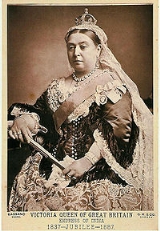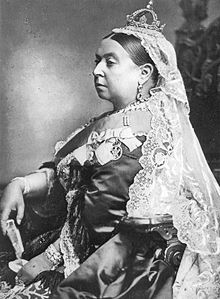
Small diamond crown of Queen Victoria
Encyclopedia

Crown (headgear)
A crown is the traditional symbolic form of headgear worn by a monarch or by a deity, for whom the crown traditionally represents power, legitimacy, immortality, righteousness, victory, triumph, resurrection, honour and glory of life after death. In art, the crown may be shown being offered to...
created at the request of Queen Victoria of the United Kingdom
Victoria of the United Kingdom
Victoria was the monarch of the United Kingdom of Great Britain and Ireland from 20 June 1837 until her death. From 1 May 1876, she used the additional title of Empress of India....
in 1870. It was perhaps the crown most associated with Queen Victoria. Such was the association that it, and not either the traditional St. Edward's Crown
St. Edward's Crown
St Edward's Crown was one of the English Crown Jewels and remains one of the senior British Crown Jewels, being the official coronation crown used in the coronation of first English, then British, and finally Commonwealth realms monarchs...
or her own Imperial State Crown
Imperial State Crown
The Imperial State Crown is one of the Crown Jewels of the United Kingdom.- Design :The Crown is of a design similar to St Edward's Crown: it includes a base of four crosses pattée alternating with four fleurs-de-lis, above which are four half-arches surmounted by a cross. Inside is a velvet cap...
, was placed on her coffin
Coffin
A coffin is a funerary box used in the display and containment of dead people – either for burial or cremation.Contemporary North American English makes a distinction between "coffin", which is generally understood to denote a funerary box having six sides in plan view, and "casket", which...
before her funeral.
Origins
Following the death of Prince Albert of Saxe-Coburg-Gotha, Victoria's husband, in 1861, Queen Victoria withdrew from public life and wore widow's weedsMourning
Mourning is, in the simplest sense, synonymous with grief over the death of someone. The word is also used to describe a cultural complex of behaviours in which the bereaved participate or are expected to participate...
, which she continued to wear until her death in 1901. Under government pressure she came back into public view in 1870. However she did not wish to wear her Imperial State Crown
Imperial State Crown
The Imperial State Crown is one of the Crown Jewels of the United Kingdom.- Design :The Crown is of a design similar to St Edward's Crown: it includes a base of four crosses pattée alternating with four fleurs-de-lis, above which are four half-arches surmounted by a cross. Inside is a velvet cap...
again, partly because she found it very heavy and uncomfortable to wear, and partly because it would have been impossible to wear with her mourning
Mourning
Mourning is, in the simplest sense, synonymous with grief over the death of someone. The word is also used to describe a cultural complex of behaviours in which the bereaved participate or are expected to participate...
veil
Veil
A veil is an article of clothing, worn almost exclusively by women, that is intended to cover some part of the head or face.One view is that as a religious item, it is intended to show honor to an object or space...
. The new small crown was created as a replacement. Because of its size it could be worn on top of her veil, so meeting both the ceremonial needs of the British
United Kingdom
The United Kingdom of Great Britain and Northern IrelandIn the United Kingdom and Dependencies, other languages have been officially recognised as legitimate autochthonous languages under the European Charter for Regional or Minority Languages...
monarchy
Monarchy
A monarchy is a form of government in which the office of head of state is usually held until death or abdication and is often hereditary and includes a royal house. In some cases, the monarch is elected...
and her own desired form of dress as a widow
Widow
A widow is a woman whose spouse has died, while a widower is a man whose spouse has died. The state of having lost one's spouse to death is termed widowhood or occasionally viduity. The adjective form is widowed...
.
Design
The crown followed standard design for British crowns. It was made up of four half-arches, which met at a mondeMonde (crown)
A monde is a ball-like object located near the top of a crown. It is the point at which a crown's half arches meet. It is usually topped off either with a national or religious symbol, for example a cross in Christian countries....
, on which sat a cross. Each half-arch ran from the monde down to a cross pattee
Cross pattée (crown)
Many crowns worn by monarchs have jewelled cross pattée symbols mounted atop the band. Most crowns possess at least four such crosses, from which the half arches rise...
along the band at the bottom. Between each cross pattee was a fleur-de-lis
Fleur-de-lis
The fleur-de-lis or fleur-de-lys is a stylized lily or iris that is used as a decorative design or symbol. It may be "at one and the same time, political, dynastic, artistic, emblematic, and symbolic", especially in heraldry...
.
However because of its small size (9 centimetres across and 10 centimetres high) Victoria's small diamond crown possesses no internal cloth cap
Cap (crown)
The cap of a crown is the cap which fills the inner space of a modern crown. While ancient crowns contained no cap, from mediæval times it became traditional to fill the circlet with a cap of velvet or other such cloth, with a base of ermine....
.
The crown was manufactured by R & S Garrard & Company
Garrard & Co
Garrard & Co is a luxury jewellery and silver company founded by George Wickesin London in 1735. Its current base is at Albemarle Street in Mayfair, London, its USA flagship store is in New York. The company also has a presence in Tokyo, New York, Dubai, Moscow and Hong Kong...
.

Jewels
The crown itself is made of silverSilver
Silver is a metallic chemical element with the chemical symbol Ag and atomic number 47. A soft, white, lustrous transition metal, it has the highest electrical conductivity of any element and the highest thermal conductivity of any metal...
. It contains 1,187 diamond
Diamond
In mineralogy, diamond is an allotrope of carbon, where the carbon atoms are arranged in a variation of the face-centered cubic crystal structure called a diamond lattice. Diamond is less stable than graphite, but the conversion rate from diamond to graphite is negligible at ambient conditions...
s. Diamonds, unlike coloured stones
Gemstone
A gemstone or gem is a piece of mineral, which, in cut and polished form, is used to make jewelry or other adornments...
, were seen as permissible to wear in mourning. The diamonds all came from a necklace owned by Queen Victoria.
Usage
Queen Victoria first used the new crown at the State Opening of ParliamentState Opening of Parliament
In the United Kingdom, the State Opening of Parliament is an annual event that marks the commencement of a session of the Parliament of the United Kingdom. It is held in the House of Lords Chamber, usually in November or December or, in a general election year, when the new Parliament first assembles...
in Westminster
Palace of Westminster
The Palace of Westminster, also known as the Houses of Parliament or Westminster Palace, is the meeting place of the two houses of the Parliament of the United Kingdom—the House of Lords and the House of Commons...
on 9 February 1871. It was worn by her on all state occasions after that date where she was required to wear a crown.
After Victoria
The small diamond crown had technically belonged to Queen Victoria personally, rather than to the British Crown, and thus was not part of the British Crown Jewels. In her willWill (law)
A will or testament is a legal declaration by which a person, the testator, names one or more persons to manage his/her estate and provides for the transfer of his/her property at death...
Victoria left it to the British Crown. It was subsequently worn on occasions by the Queen consort
Queen consort
A queen consort is the wife of a reigning king. A queen consort usually shares her husband's rank and holds the feminine equivalent of the king's monarchical titles. Historically, queens consort do not share the king regnant's political and military powers. Most queens in history were queens consort...
, Alexandra of Denmark
Alexandra of Denmark
Alexandra of Denmark was the wife of Edward VII of the United Kingdom...
(1901-1910) and after her by the next Queen consort, Mary of Teck
Mary of Teck
Mary of Teck was the queen consort of the United Kingdom and the British Dominions, and Empress of India, as the wife of King-Emperor George V....
. After the death of Mary's husband, George V
George V of the United Kingdom
George V was King of the United Kingdom and the British Dominions, and Emperor of India, from 6 May 1910 through the First World War until his death in 1936....
, the crown ceased to be worn by her. When the new Queen consort, Elizabeth Bowes-Lyon decided not to wear the small diamond crown, it was deposited in the Jewel House in the Tower of London
Tower of London
Her Majesty's Royal Palace and Fortress, more commonly known as the Tower of London, is a historic castle on the north bank of the River Thames in central London, England. It lies within the London Borough of Tower Hamlets, separated from the eastern edge of the City of London by the open space...
in 1937, where it remains on show.

